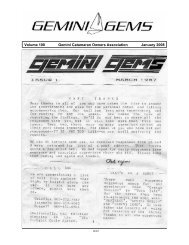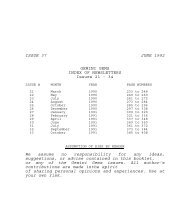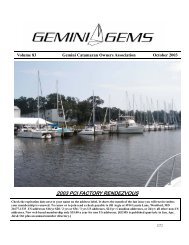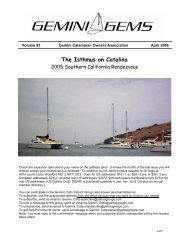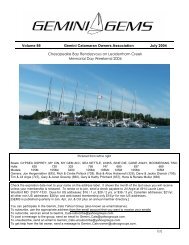Gemini Owners Manual.pub - Gemini Gems
Gemini Owners Manual.pub - Gemini Gems
Gemini Owners Manual.pub - Gemini Gems
Create successful ePaper yourself
Turn your PDF publications into a flip-book with our unique Google optimized e-Paper software.
<strong>Gemini</strong> 105Mc Owner’s <strong>Manual</strong><br />
Batteries<br />
The <strong>Gemini</strong> comes with (3) three batteries #24 Deka<br />
Deep Cycle Marine Batteries. There is room for (1)<br />
one additional battery.<br />
The batteries are number 24, deep cycle with a<br />
capacity of 85 amps each. On the battery switch,<br />
“Battery One” refers to two batteries connected<br />
together while “Battery Two” refers to the singular<br />
battery.<br />
A Note on Deep Cycle Batteries: Unlike conventional<br />
car batteries, deep cycle batteries hold a<br />
charge better and retain an almost constant voltage<br />
until just before the battery dies. However, in retaining<br />
an almost constant voltage, it is difficult to<br />
tell how much charge is left in the battery. The<br />
only accurate way is with the use of a hydrometer<br />
to check the acidity of the battery fluid. Battery<br />
managers that measure the flow of current into and<br />
out of the battery are good for continuous use but<br />
do not work well if the boat is left for long periods<br />
of time without use. Batteries lose charge by internal<br />
degradation at the rate of as much as 1/8 ampere<br />
an hour. As batteries are used, the distilled<br />
water changes to sulfuric acid and eventually the<br />
formation of sulfate crystals coats the plates in the<br />
battery and the capacity of the battery is reduced.<br />
For example, if the battery is left at 60% charge for<br />
long periods of time, then the battery will not accept<br />
a charge of more than 60% while charging. It<br />
is possible to tell when the battery is near dead<br />
when it can be fully charged in a short time.<br />
Solar power is an efficient way to keep batteries in<br />
good condition as solar power puts out low current<br />
at high voltage. The solar panel, available as an<br />
option, charge at up to 10 amps per hour.<br />
A battery can be charged to 80% easily but the last<br />
20% of charge requires a lot of time so that the battery<br />
is not overheated. That is why running the<br />
engine to charge the batteries is not efficient no<br />
matter what capacity alternator is in use.<br />
The new smart chargers require a thermometer on<br />
the battery.<br />
Gel cell batteries are expensive and can be damaged<br />
by over heating and theoretically can only be<br />
charged and discharged one quarter as many times<br />
as deep cycle batteries.<br />
Checking Battery Levels<br />
Deka recommends checking the electrolyte fluid in<br />
your batteries weekly and/or before any prolonged<br />
battery charging, such as extensive motoring.<br />
Checking the batter level simply means ensuring<br />
the electrolyte is filled to the indicator line on the<br />
battery case (which covers the plates). If the bat-<br />
12 Volt Power<br />
tery needs fluid, use only distilled water. To go a<br />
step further, you can use a hydrometer to test for a<br />
specific gravity of 1265 following a charge. Start<br />
with the cell closest to the (+) terminal. The specific<br />
gravity reading should be between 1.100 and<br />
1.300 (Specifically 1.265).<br />
Be sure to keep the battery connections clean as this<br />
will help ensure longer battery life.<br />
Battery Monitors<br />
Battery monitors measure everything that goes in<br />
and out of a battery through the negative side. This<br />
is a highly effective way of keeping track of available<br />
power. A voltmeter is not accurate enough as it will<br />
not tell you what state of charge your battery is in.<br />
Battery Switch<br />
The battery switch is located above the batteries.<br />
Caution: Never switch from position “1” to position<br />
“2” through “OFF” – especially when the engine<br />
is running as damage to the alternator could<br />
occur. Always switch through the “BOTH” position.<br />
With Battery “1” selected on the battery switch, all<br />
12 volt power is coming from the first set of batteries<br />
and only the first set of batteries are receiving a<br />
charge from the alternator with the engine running.<br />
Battery “2” is not in use. When battery “2” is selected<br />
all 12 volt power is coming from the single<br />
battery and the single battery is receiving a charge<br />
from the alternator with the engine running.<br />
If battery “1” is used and left fully charged before<br />
switching to battery “2”, then there will always be a<br />
full spare battery and vice versa.<br />
The <strong>Gemini</strong> does not make use of a designated engine<br />
starter battery as the smaller Westerbeke engine<br />
does not require a large amount of current to<br />
start. In addition, a designated starter battery requires<br />
the use of an automatic switch. With an automatic<br />
switch, once the engine is started, first the<br />
engine battery is fully charged and once it reaches<br />
13.8 volts then the other ship’s batteries are<br />
charged. The problem with this system, as discussed<br />
earlier, is that it is easier to charge a flat battery<br />
Copyright © 2004 Performance Cruising Inc.<br />
17



